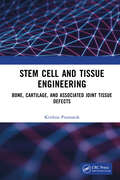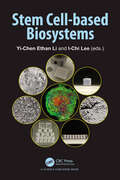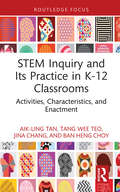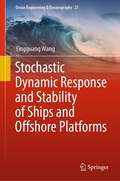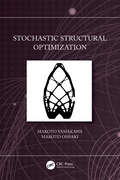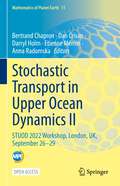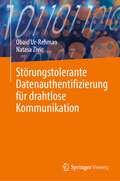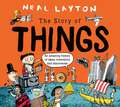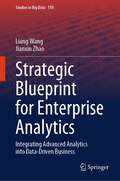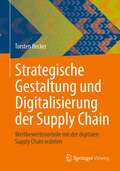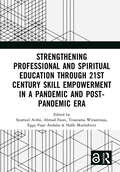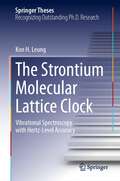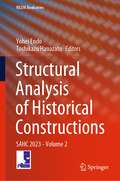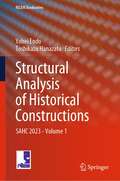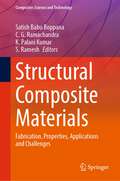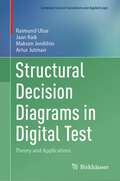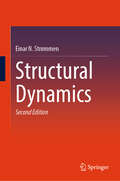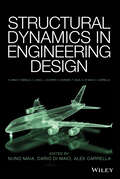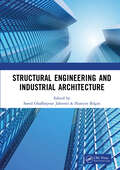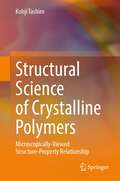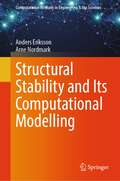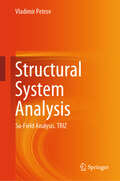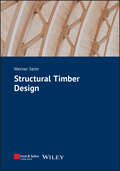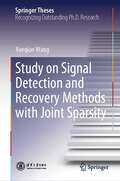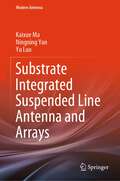- Table View
- List View
Stem Cell and Tissue Engineering: Bone, Cartilage, and Associated Joint Tissue Defects
by Krishna PramanikThis book covers conventional clinical treatment methods for handling bone, cartilage, and related disorders along with their limitations and highlights the current state of the art of tissue engineering as an alternative for regenerating such defective tissue. Potential biomimetic scaffolding materials and their development, desired properties, modifications, and optimizations are described. The design and advancement in fabrication, characterization, properties, and biological functions of scaffolds, their integration with stem cells, and various bioreactor systems for tissue regeneration are presented. It further reviews in vitro and in vivo (pre-clinical) assessments of tissue constructs, involved translational challenges, and strategies in various stages of neo-tissue production.Features: Discusses the key aspects of generating engineered bone, cartilage, and associated tissues through tissue engineering approach Describes multiple engineering principles, and processes involved in the various stages of developing biomaterials and scaffolds Covers integration of stem cells with scaffolds, including assessment of tissue grafts, and translational strategy Explores key factors influencing tissue graft generation in bioreactors and challenges involved in various stages Includes several exercises including review questions and numerical problems for better understanding of the subject This book is aimed at researchers, students, and professionals in biomedical engineering, tissue engineering, stem cells, biomaterials, and orthopaedics.
Stem Cell-based Biosystems
by Yi-Chen Ethan Li I-Chi LeeStem cell science has emerged as a novel discipline in biomedical research over the past decade. With advancements in this field, stem cells have demonstrated versatile applications ranging from basic research to clinical case studies. Recognizing the demand for knowledge in stem cell applications, this book aims to provide comprehensive information on stem cell technology and its application in biosystems. It covers fundamental culture methods, advanced stem cell-based biosystems, and clinical case studies of stem cell therapy. This book is intended for individuals with an interest in stem cell science, offering valuable insights into this rapidly evolving field.
STEM Inquiry and Its Practice in K-12 Classrooms: Activities, Characteristics, and Enactment (Routledge Research in STEM Education)
by Aik-Ling Tan Tang Wee Teo Jina Chang Ban Heng ChoyThrough examining the theoretical ideas of disciplinarity and disciplinary practices, the book presents instructional aspects for teachers to explore when engaged with integrated STEM inquiry.Are you interested to understand the difference between science inquiry and STEM inquiry? Do you want to introduce integrated STEM problem solving to your students but need help with the key features of STEM inquiry? This book presents in-depth discussions related to the features and affordances of integrated STEM inquiry. Written for K-12 teachers and teacher educators, this book conceptualises STEM inquiry and integrated STEM and their enactment, using three practical STEM instructional frameworks: problem-centric, solution/design-centric, and user-centric STEM. The three STEM instructional frameworks serve as a key anchor for teachers to interpret and apply when planning various STEM lessons in meaningful, practical, and coherent ways.Whether you are an aspiring K-12 STEM teacher or an in-service teacher teaching K-12 students, the ideas of integrated STEM inquiry presented in this book challenge educators to think about the principles of integrated STEM inquiry and how they can be incorporated into classroom practice and lessons.
Stochastic Dynamic Response and Stability of Ships and Offshore Platforms (Ocean Engineering & Oceanography #27)
by Yingguang WangThis textbook investigates in detail the methods for stochastic dynamic response and stability analyses of nonlinear systems (especially ships and ocean engineering systems), elucidating the advantages and disadvantages of each of the methods (the statistical linearization method, the perturbation method, the Monte Carlo Simulation method, the numerical path integration method, the global geometric method and the first passage theory). Studies on stochastic dynamic analysis of nonlinear systems have attracted engineers and scientists from various disciplines, such as aeronautical, civil, mechanical and ocean engineering. Pursuing a systematic approach, this book establishes a fundamental framework for this topic, while emphasizing the importance of accurate and efficient analysis as well as the significant influence of choosing a suitable method in the design and optimization of various nonlinear engineering systems (especially ships and ocean engineering systems).The textbook is intended for upper undergraduate and graduate students who are interested in advanced dynamic analysis technologies, researchers investigating nonlinear systems under stochastic dynamic excitations, and civil/mechanical/structural/ocean engineers working on designing and optimization of real-world nonlinear engineering systems. The basis of English translation of this book from its Chinese original manuscript was done with the help of artificial intelligence. A subsequent human revision of the content was done by the author.
Stochastic Structural Optimization
by Makoto Yamakawa Makoto OhsakiStochastic Structural Optimization presents a comprehensive picture of robust design optimization of structures, focused on nonparametric stochastic-based methodologies. Good practical structural design accounts for uncertainty, for which reliability-based design offers a standard approach, usually incorporating assumptions on probability functions which are often unknown. By comparison, a worst-case approach with bounded support used as a robust design offers simplicity and a lower level of sensitivity. Linking structural optimization with these two approaches by a unified framework of non-parametric stochastic methodologies provides a rigorous theoretical background and high level of practicality. This text shows how to use this theoretical framework in civil and mechanical engineering practice to design a safe structure which accounts for uncertainty. Connects theory with practice in the robust design optimization of structures Advanced enough to support sound practical designs This book provides comprehensive coverage for engineers and graduate students in civil and mechanical engineering.Makoto Yamakawa is a Professor at Tokyo University of Science, and a member of the Advisory Board of the 2020 Asian Congress of Structural and Multidisciplinary Optimization. Makoto Ohsaki is a Professor at Kyoto University, Japan, treasurer of the International Association for Shell & Spatial Structures and former President of the Asian Society for Structural and Multidisciplinary Optimization.
Stochastic Transport in Upper Ocean Dynamics II: STUOD 2022 Workshop, London, UK, September 26–29 (Mathematics of Planet Earth #11)
by Bertrand Chapron Dan Crisan Darryl Holm Etienne Mémin Anna RadomskaThis open access proceedings volume brings selected, peer-reviewed contributions presented at the Third Stochastic Transport in Upper Ocean Dynamics (STUOD) 2022 Workshop, held virtually and in person at the Imperial College London, UK, September 26–29, 2022. The STUOD project is supported by an ERC Synergy Grant, and led by Imperial College London, the National Institute for Research in Computer Science and Automatic Control (INRIA) and the French Research Institute for Exploitation of the Sea (IFREMER). The project aims to deliver new capabilities for assessing variability and uncertainty in upper ocean dynamics. It will provide decision makers a means of quantifying the effects of local patterns of sea level rise, heat uptake, carbon storage and change of oxygen content and pH in the ocean. Its multimodal monitoring will enhance the scientific understanding of marine debris transport, tracking of oil spills and accumulation of plastic in the sea.All topics of these proceedings are essential to the scientific foundations of oceanography which has a vital role in climate science. Studies convened in this volume focus on a range of fundamental areas, including:Observations at a high resolution of upper ocean properties such as temperature, salinity, topography, wind, waves and velocity;Large scale numerical simulations;Data-based stochastic equations for upper ocean dynamics that quantify simulation error;Stochastic data assimilation to reduce uncertainty.These fundamental subjects in modern science and technology are urgently required in order to meet the challenges of climate change faced today by human society. This proceedings volume represents a lasting legacy of crucial scientific expertise to help meet this ongoing challenge, for the benefit of academics and professionals in pure and applied mathematics, computational science, data analysis, data assimilation and oceanography.
Störungstolerante Datenauthentifizierung für drahtlose Kommunikation
by Obaid Ur-Rehman Natasa ZivicDieses Buch gibt einen Einblick in die Herausforderungen der Datenauthentifizierung über drahtlose Kommunikationskanäle. Die Autoren gehen davon aus, dass die etablierten Standard-Authentifizierungsmechanismen nicht ausreichen, um Daten wie Sprache, Bilder und Videos über drahtlose Kanäle zu authentifizieren, da die drahtlose Kommunikation durch zahlreiche Störungen gekennzeichnet ist. Die Autoren schlagen neue Mechanismen vor, die auf so genannten Soft-Authentifizierungsalgorithmen basieren, die einige Änderungen an den zu schützenden Daten tolerieren. Die Autoren erklären, dass das Ziel dieser Algorithmen darin besteht, tolerant gegenüber inhaltlichen Änderungen auf Grund von Übertragungsfehler zu sein, aber dennoch in der Lage zu sein, Fälschungen zu erkennen. Ein weiterer Vorteil der Soft-Authentifizierungsalgorithmen besteht darin, dass sie in der Lage sind, die veränderten Stellen zu identifizieren und sie nach Möglichkeit zu korrigieren. Die Autoren zeigen, wie man dies erreicht, indem man die Datenmerkmale mit Hilfe von fehlerkorrigierenden Codes schützt. · Erörtert Methoden zur Authentifizierung von Daten (insbesondere von Bildern) bei Übertragungsstörungen, die bei der drahtlosen Kommunikation auftreten; · Stellt eine neue Klasse von Soft-Authentifizierungsmethoden vor, die anstelle der üblichen Hard-Authentifizierungsmethoden verwendet werden, um geringfügige Änderungen der Bilddaten zu tolerieren; · Verfügt über Authentifizierungsmethoden, die auf der Verwendung von Authentifizierungscodes und digitalen Wasserzeichen basieren
The Story Of Things
by Neal LaytonTake a fascinating journey through time to explore a world full of ideas, inventions, discoveries and many, many ... things! Have you ever wondered how us humans came to have so many 'things'?Starting with the early humans who had very few things, through to the jam-packed world we live in today, discover how from the very beginning we humans have had the urge to invent and create! From the creation of Stone Age tools and the first handwritten book through to amazing inventions including the steam engine and the laptop computer, find out how things have transformed our world.With fun illustrations and witty text by award-winning author and illustrator Neal Layton.
Strategic Blueprint for Enterprise Analytics: Integrating Advanced Analytics into Data-Driven Business (Studies in Big Data #150)
by Liang Wang Jianxin ZhaoThis book is a comprehensive guide for professionals, leaders, and academics seeking to unlock the power of data and analytics in the modern business landscape. It delves deeply into the strategic, architectural, and managerial aspects of implementing enterprise analytics (EA) systems in large enterprises. The book is meticulously structured into three parts. Part 1 lays the foundation for adaptable architecture in EA. Part 2 explores technical considerations: data, cloud platforms, and AI solutions. The final part focuses on strategy execution, investment, and risk management. Acting as a comprehensive guide, the book enables the creation of robust EA capabilities that foster growth, optimize operations, and keep pace with EA's dynamic world. Whether readers are leaders harnessing data's potential, practitioners navigating analytics, or academics exploring this evolving domain, this book provides insights and knowledge to guide readers toward a thriving, data-driven future.
Strategische Gestaltung und Digitalisierung der Supply Chain: Wettbewerbsvorteile mit der digitalen Supply Chain erzielen
by Torsten BeckerDigitale Supply Chains steigern die Wettbewerbsfähigkeit von Unternehmen. Eine systematische Vorgehensweise beschreibt die Entwicklung von Strategien, um mit der Supply Chain und deren Digitalisierung herausfordernde Unternehmensziele zu erreichen. Dazu zählen die bessere Erfüllung von Kundenanforderungen, Umsatzsteigerung und gleichzeitig Kostensenkung. Strategiemuster werden vorgestellt und deren Umsetzung in Unternehmen beschrieben. Unternehmer, Supply-Chain- und Operations-Führungskräfte erhalten einen praxisorientierten Leitfaden, wie sie Ihr Unternehmen für die Zukunft ausrichten können. Die vorgestellten, praxiserprobten Methoden und Ansätze beschleunigen und erleichtern nicht nur die Strategieentwicklung, sondern auch deren Umsetzung und die Unterstützung durch digitale Lösungen.Dabei stehen Make-/Buy-Entscheidungen, Lösungen für Entscheidung über Fähigkeiten, die digitale Lösungen in der Produktionstechnik (3D-Druck) sowie die Auswirkungen von Industrie 4.0 und Umweltaspekten auf die Supply Chain im Fokus. Praxisbeispiele zeigen, wie neue Lösungskonzepte die Auslegung von zukunftsgerichteten Supply Chains unterstützen. Ebenso werden die Triggerpunkte vorgestellt, die eine erfolgreiche Supply Chain in Frage stellen könnten, sowie die Gestaltung zur Zeit- und Kostenoptimierung in der Gesamtkette. Wie muss ein Unternehmen die historisch gewachsene Supply Chain grundsätzlich in Frage stellen? Was ist wichtig bei einer Supply Chain Optimierung? Die Betrachtung gilt den Strategien, die die Prozesse, Architekturen, die Nutzung digitaler Technologien, den Ressourceneinsatz bestimmen - unter Berücksichtigung der übergeordneten Unternehmensstrategie, die kürzere Lieferzeiten und geringeren Kosten fordert, um wettbewerbsfähig bleiben zu können. Es wird eine Handlungsanleitung zur strategischen Gestaltung für digitale Supply Chains vorgestellt.
Strengthening Professional and Spiritual Education through 21st Century Skill Empowerment in a Pandemic and Post-Pandemic Era: Proceedings of the 1st International Conference on Education (ICEdu 2022), September 28, 2022, Malang, Indonesia
by Syamsul Arifin Ahmad Fauzi Triastama Wiraatmaja Eggy Fajar Andalas Nafik MuthohirinDiscover a treasure trove of knowledge in the proceedings of the First International Confer-ence on Education (ICEdu). This meticulously curated collection of research papers delves into the transformative landscape of education in the 21st century, offering insights, solutions, and inspiration for educators, researchers, and policymakers alike.Explore a diverse range of subject areas, from pedagogical innovations to the challenges of digital learning and the impact of the COVID-19 pandemic on education. With 28 scholarly papers contributed by experts from around the world, this volume offers a comprehensive un-derstanding of the multifaceted issues in contemporary education.Whether you're an academic seeking fresh perspectives or an educator navigating the com-plexities of modern pedagogy, these proceedings provide invaluable guidance. Join us in shap-ing the future of education by harnessing the power of 21st-century skills, professional devel-opment, and spiritual growth.This book is an essential resource for anyone passionate about the advancement of education in the pandemic and post-pandemic era.The Open Access version of this book, available at http://www.taylorfrancis.com, has been made available under a Creative Commons Attribution-Non Commercial-No Derivatives (CC-BY-NC-ND) 4.0 license. Funded by Universitas Muhammadiyah Malang, Indonesia.
The Strontium Molecular Lattice Clock: Vibrational Spectroscopy with Hertz-Level Accuracy (Springer Theses)
by Kon H. LeungThis thesis describes how the rich internal degrees of freedom of molecules can be exploited to construct the first “clock” based on ultracold molecules, rather than atoms. By holding the molecules in an optical lattice trap, the vibrational clock is engineered to have a high oscillation quality factor, facilitating the full characterization of frequency shifts affecting the clock at the hertz level. The prototypical vibrational molecular clock is shown to have a systematic fractional uncertainty at the 14th decimal place, matching the performance of the earliest optical atomic lattice clocks. As part of this effort, deeply bound strontium dimers are coherently created, and ultracold collisions of these Van der Waals molecules are studied for the first time, revealing inelastic losses at the universal rate. The thesis reports one of the most accurate measurements of a molecule’s vibrational transition frequency to date. The molecular clock lays the groundwork for explorations into terahertz metrology, quantum chemistry, and fundamental interactions at atomic length scales.
Structural Analysis of Historical Constructions: SAHC 2023 - Volume 2 (RILEM Bookseries #46)
by Yohei Endo Toshikazu HanazatoThis book gathers the peer-reviewed papers presented at the 13th International Conference on Structural Analysis of Historical Constructions (SAHC), held in Kyoto, Japan, on September 12-15, 2023. It highlights the latest advances and innovations in the field of conservation and restoration of historical and heritage structures. The conference topics encompass history of construction and building technology, theory and practice of conservation, inspection methods, non-destructive techniques and laboratory testing, numerical modeling and structural analysis, management of heritage structures and conservation strategies, structural health monitoring, repair and strengthening strategies and techniques, vernacular constructions, seismic analysis and retrofit, vulnerability and risk analysis, resilience of historic areas to climate change and hazard events, durability, and sustainability. As such the book represents an invaluable, up-to-the-minute tool, providing an essential overview of conservation of historical constructions, and offers an important platform to engineers, architects, archeologists, and geophysicists.Chapter The Challenges of the Conservation of Earthen Sites in Seismic Areas, Chapter Performance Evaluation of Patch Repairs on Historic Concrete Structures (PEPS): Preliminary Results from Two English Case Studies are available open access under a Creative Commons Attribution 4.0 International License via link.springer.com.
Structural Analysis of Historical Constructions: SAHC 2023 - Volume 1 (RILEM Bookseries #47)
by Yohei Endo Toshikazu HanazatoThis book gathers the peer-reviewed papers presented at the 13th International Conference on Structural Analysis of Historical Constructions (SAHC), held in Kyoto, Japan, on September 12-15, 2023. It highlights the latest advances and innovations in the field of conservation and restoration of historical and heritage structures. The conference topics encompass history of construction and building technology, theory and practice of conservation, inspection methods, non-destructive techniques and laboratory testing, numerical modeling and structural analysis, management of heritage structures and conservation strategies, structural health monitoring, repair and strengthening strategies and techniques, vernacular constructions, seismic analysis and retrofit, vulnerability and risk analysis, resilience of historic areas to climate change and hazard events, durability, and sustainability. As such the book represents an invaluable, up-to-the-minute tool, providing an essential overview of conservation of historical constructions, and offers an important platform to engineers, architects, archeologists, and geophysicists.Chapter Guidelines for Seismic Retrofitting of Earthen Historic Buildings in Peru and Latin America is available open access under a Creative Commons Attribution 4.0 International License via link.springer.com.
Structural Composite Materials: Fabrication, Properties, Applications and Challenges (Composites Science and Technology)
by Satish Babu Boppana C. G. Ramachandra K. Palani Kumar S. RameshThis book covers topics related to structural composite materials such as processing, characterization, applications and challenges. The book presents ways of processing composites, where different types of composites can be processed depending on the type of reinforcement and matrix. It also outlines the evaluation of mechanical properties of a few processed composites and discusses the potential applications of composites and machining challenges faced in processing polymer and ceramic composites. The book caters to material scientists, industrial practitioners, researchers and students working on structural composite materials.
Structural Decision Diagrams in Digital Test: Theory and Applications (Computer Science Foundations and Applied Logic)
by Raimund Ubar Jaan Raik Maksim Jenihhin Artur JutmanThis is the first book that sums up test-related modeling of digital circuits and systems by a new structural-decision-diagrams model. The model represents structural and functional information jointly and opens a new area of research.The book introduces and discusses applications of two types of structural decision diagrams (DDs): low-level, structurally synthesized binary DDs (SSBDDs) and high-level DDs (HLDDs) that enable diagnostic modeling of complex digital circuits and systems.Topics and features:Provides the definition, properties and techniques for synthesis, compression and optimization of SSBDDs and HLDDsProvides numerous working examples that illustrate the key points of the textDescribes applications of SSBDDs and HLDDs for various electronic design automation (EDA) tasks, such as logic-level fault modeling and simulation, multi-valued simulation, timing-critical path identification, and test generationDiscusses the advantages of the proposed model to traditional binary decision diagrams and other traditional design representationsCombines SSBDDs with HLDDs for multi-level representation of digital systems for enabling hierarchical and cross-level solving of complex test-related tasksThis unique book is aimed at researchers working in the fields of computer science and computer engineering, focusing on test, diagnosis and dependability of digital systems. It can also serve as a reference for graduate- and advanced undergraduate-level computer engineering and electronics courses.Three authors are affiliated with the Dept. of Computer Systems at the Tallinn University of Technology, Estonia: Raimund Ubar is a retired Professor, Jaan Raik and Maksim Jenihhin are tenured Professors. Artur Jutman, PhD, is a researcher at the same university and the CEO of Testonica Lab Ltd., Estonia.
Structural Dynamics
by Einar N. StrømmenThe first part of this book covers the general theory of structural dynamics, in a calculous format as well as a finite element formulation. Secondly, it contains methods of eigenvalue calculations of civil engineering structural systems. And third, it contains a major part covering dynamic displacement response calculations as induced by earthquake, turbulent wind, vortex shedding and moving vehicles, enabling the designer to evaluate structural safety from the effects of fluctuating internal forces.The general theory contains comprehensive development of the principle of virtual displacements, as well as the Galerkin solution to eigenvalue problems. A separate chapter has been dedicated to the suspension bridge. The theory of single or multiple tuned mass dampers is included, a theory not presented elsewhere.The book contains a chapter covering the theory of structural damping, as well as comprehensive data of the structural damping properties that are necessary forany dynamic response calculation. The book is intended for students as well as practising engineers. It contains numerous relevant examples, covering numerical solutions that are well suited for computer programming.
Structural Dynamics in Engineering Design
by Nuno M. M. Maia Dario Di Maio Alex Carrella Francesco Marulo Chaoping Zang Jonathan E. Cooper Keith Worden Tiago A. N. SilvaWorld-class authors describe and illustrate how structural dynamics is applied to the engineering design process Structural Dynamics in Engineering Design covers the fundamentals of structural dynamics and its application to the engineering design process, providing all of the necessary information to implement an optimal design process. Each of its seven chapters is written by an expert in the field and provides the reader with the structural dynamic theoretical background and its more practical aspects for the implementation of an advanced design capability. The first three chapters are dedicated to the underlying theory of the three main processes: the fundamentals of vibration theory, the basis of experimental dynamics and the main numerical analysis tools (including reference to the finite element method). Having laid the foundation of the design philosophy, the following three chapters present the reader with the three disciplines of identification, nonlinear analysis and validation/updating. The final chapter presents some applications of the approach to real and complex engineering cases. Key features: Takes a multi-disciplinary approach and contains critical information on theory, testing and numerical analysis for structural dynamics. Includes a chapter on industrial applications (including aircraft design and ground vibration testing), which illustrates the design process and explains how structural dynamics is applied at different stages. The book is a must-have for researchers and practitioners in mechanical and aerospace engineering (in particular test engineers, CAE analysts and structural dynamicists), as well as graduate students in mechanical and aerospace engineering departments.
Structural Engineering and Industrial Architecture: Proceedings of 6th International Conference on Structural Engineering and Industrial Architecture (ICSEIA 2023), Changsha, China, 24-26 February 2023
by Saeed Ghaffarpour Jahromi Huseyin BilginStructural Engineering and Industrial Architecture collects the contributions presented at the 6th International Conference on Structural Engineering and Industrial Architecture (ICSEIA 2023, Changsha, China, 24-26 February 2023). The book gathers cutting-edge research and achievements on a wide range of topics, including: - Civil Engineering - Engineering Structure - Environmental Protection Materials - Architectural Environment - Seismic Engineering The book is aimed at academics and engineering working or interested in the above-mentioned areas.
Structural Science of Crystalline Polymers: Microscopically-Viewed Structure-Property Relationship
by Kohji TashiroThis book focuses on methods of how to understand the relationship between the structure and physical properties of polymers from the microscopic point of view on the basis of experimental and theoretical methodologies. It is the second volume of a two volume set with Structural Science of Crystalline Polymers. The first volume of the series, “Structural Science of Crystalline Polymers: Basic Concepts and Practices” describes the details of techniques for analysis of the hierarchical structure of crystalline polymers from both the experimental and theoretical points of view. Readers of the first volume who master the concrete techniques and concepts necessary for the analysis of the structure of polymers are now invited to begin this second volume. The methods introduced in this book are useful not only for understanding the physical properties of crystalline regions but also for interpreting the bulk properties of polymer materials from the 3D structural point of view. Forthis purpose, a concrete description is provided so that readers can use the theory or the program in the actual interpretation of physical properties. The physical properties of polymers are intimately related to the structural evolution in the crystallization process and also the structural changes in the samples subjected to an external field. Concrete methods and examples are introduced for these studies, making the book a useful and practical guide for young professional researchers, including those working in industry. At the same time, it can also be used as an excellent reference for graduate-level students.
Structural Stability and Its Computational Modelling (Computational Methods in Engineering & the Sciences)
by Anders Eriksson Arne NordmarkThe volume showcases how basic formulation and solution methods can be used for an improved understanding of stability-affected structures. It also highlights the numerical treatment of the resulting equations, demonstrating and quantifying many aspects of structural stability not available to engineers by the traditional methods. The elaborated theoretical background is also used to show how methods included in commercial software can give misleading conclusions. The book will be of interest to researchers and professionals working in computational modelling of structures. The book includes exercises and projects, appended to each chapter, which further extends its usability as a text book in classroom teaching and for professional courses.
Structural System Analysis: Su-Field Analysis. TRIZ
by Vladimir PetrovThis book provides a comprehensive exploration of SU-Field Analysis, a groundbreaking framework that delves into the intricate realms of fields, substances, and interactions. It commences with an introduction to the fundamental concepts (Chapter 1), followed by an elucidation of the basic configurations (Chapter 2) and an in-depth examination of various SU-Field systems (Chapter 3). Within Chapter 3, the text delves into the SU-Field model for fields, types of SU-Field systems for measurement and detection, and various SU-Field models. Subsequently, the book delves into the critical subject of eliminating harmful interactions (Chapter 4), discussing trends, introducing innovative solutions like S3, and exploring the use of substances and fields to decelerate detrimental effects. In Chapter 5, the focus shifts to finding desired effects, while Chapter 6 unveils the Law of Increasing Degree of SU-Field, elucidating its general trends and the forcing of substances and fields. Further insights into this law are presented in Chapter 6.4. Additionally, the book touches upon SU-Field Analysis in the context of information systems (Chapter 7) and introduces a new SU-Field structure (Chapter 8). The latter includes discussions on general concepts, parametric analysis, patterns of control elements, energy and information control, knowledge development, and structural analysis of information processing systems. Throughout, the book offers readers a comprehensive and detailed understanding of SU-Field Analysis, making it an invaluable resource for those seeking to explore this groundbreaking field.
Structural Timber Design
by Werner SeimStructural Timber Design Timber construction has been one of the most innovative areas of the building industry for several years. The speed with which new products are introduced into practical application is almost breathtaking compared to the other construction materials in the building industry. As a result, timber construction is continuously increasing its market share in commercial buildings and hall structures, and even in multi-storey construction for residential and office buildings. This book provides essential knowledge and skills required for the design, detailing, and construction of timber structures. Special emphasis is placed on the specific features of timber and wood-based materials compared to other construction materials. This concerns the numerous advantages, as e.g. the comparatively low weight, the good workability of the high-performance material and the large variety of assembling technologies, but also the challenges resulting from the material anisotropy and from the susceptibility to natural pests. In each chapter the essential phenomena are explained first and then brought into connection with code regulations. This aims to support the basic understanding of the interrelations and dependencies in timber engineering, which is the fundamental basis of creative engineering.
Study on Signal Detection and Recovery Methods with Joint Sparsity (Springer Theses)
by Xueqian WangThe task of signal detection is deciding whether signals of interest exist by using their observed data. Furthermore, signals are reconstructed or their key parameters are estimated from the observations in the task of signal recovery. Sparsity is a natural characteristic of most of signals in practice. The fact that multiple sparse signals share the common locations of dominant coefficients is called by joint sparsity. In the context of signal processing, joint sparsity model results in higher performance of signal detection and recovery. This book focuses on the task of detecting and reconstructing signals with joint sparsity. The main contents include key methods for detection of joint sparse signals and their corresponding theoretical performance analysis, and methods for joint sparse signal recovery and their application in the context of radar imaging.
Substrate Integrated Suspended Line Antenna and Arrays (Modern Antenna)
by Kaixue Ma Ningning Yan Yu LuoThis book delves deeply into the substrate integrated suspended line antenna technologies and evaluates its potential to replace conventional three-dimensional (3D) metal-based antennas. Over the years, studies on substrate integrated suspended line antennas have captivated engineers and scientists from the antennas and related engineering fields, all aiming to achieve low-cost and low-loss characteristics. The book establishes a fundamental framework for this topic, while emphasizing the importance of substrate integrated suspended line antennas in the wireless communication and radar systems. It is designed for undergraduate and graduate students who are interested in antenna technology, researchers investigating substrate integrated technology, and antenna engineers working on low-cost and low-loss antennas and arrays.
